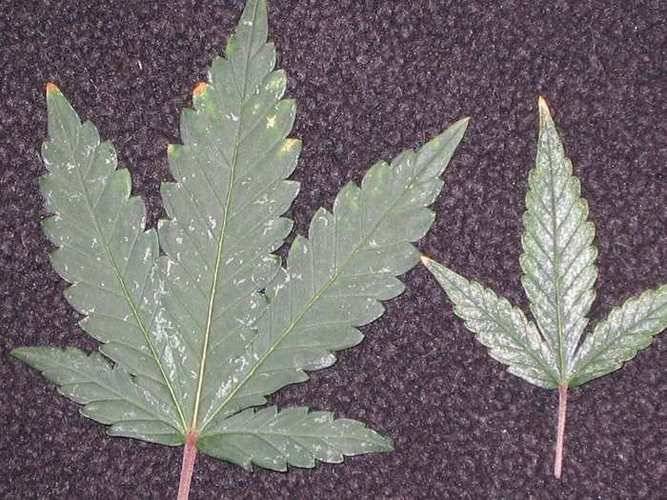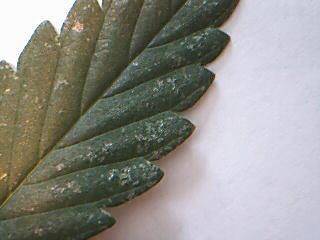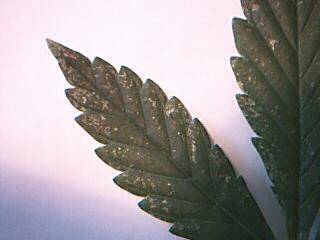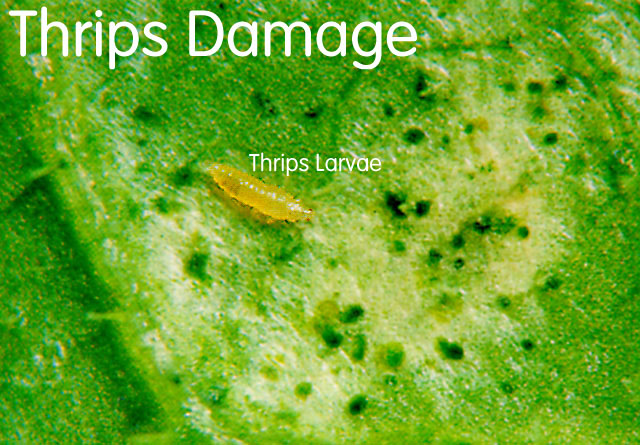K
kokua
Thrips 101: Introduction to Western Flower Thrips
There are several different types of thrips (singular and plural form)…believe it or not there are actually beneficial thrips out there Today we are going to be talking about the dreaded Western Flower Thrips.
Today we are going to be talking about the dreaded Western Flower Thrips.
Description:
Adult thrips are small slender insects about 1/20 inch long. They vary in color from light to dark brown. Wings are narrow and fringed, giving them a feathery appearance. Adult thrips are capable of flying. Nymphs are active, light-colored, wingless insects. The mouthparts of adults and nymphs are designed to rasp plant tissues then suck the juices. The last nymphal stage is spent in the soil. It’s the adults and nymphs that do most of the damage.
Thrips are tiny, but you may notice signs of their presence, such as black, shiny speckles (droppings), silvery stippling (masses of tiny discolored scars on leaves) or, in severe cases, deformed growth. Thrips feed by using their mouthparts to pierce plant cells and suck out their contents. Damaged plant cells collapse, resulting in deformed plant growth and silvered patches and flecking on leaves.
Thrips are like mites in that they prefer hot, dry conditions. When it is hot and dry populations will multiply rapidly. However, they can reproduce at almost all temperature and humidity levels in indoor garden. As with any bug that plagues our gardens, early detection is important because symptoms of feeding often go unnoticed until serious damage has occurred. Also, small populations are easier to control than large ones.
Damage:
Damage to the leaves results in light colored silvery patches or streaking, often with blackish thrips droppings in the vicinity.
**


 **
**


Life Cycle:
Eggs are laid in plant tissue and hatch in 3-5 days; nymphs feed for 1-3 weeks on your foliage, then rest in the soil or on leaves until they molt into adult form in 1-2 weeks.


Biological Control:
Tapping the flowers or foliage of a few plants gently over a sheet of white paper will dislodge thrips and make them visible. Plant tapping can be used to determine if thrips are present, and to gain a rough estimate of their numbers.
The three most popular natural predators I see recommended for thrips are the minute pirate bugs, thrips predators and nematodes.
Pirate Bugs will voraciously attack thrips. The one downside to using Pirate Bugs is that they are only effective in the veg/mom/propagation stages of growth. Pirate bugs can’t reproduce under 12/12 so they are useless in the flower room. There have been efforts to locate strains of pirate bugs that would continue to actively reproduce under short day length conditions. However, currently Pirate Bugs are not an effective control for 12/12 gardens…only 18/6.
Thrips Predators are actually predatory mites and are tan-orange in color and similar in looks and movement to the spider mite predator. These guys work good at keeping populations under control but you need to have the predator population built up and established early in the crop, even before evidence of thrips. These predators provide a means of control in the foliage but will not eliminate thrips in your garden.
Nematodes have been suggested as another possible solution for thrips control. The problem inherent in the use of nematodes is that only a small portion of the thrips population will be present in the soil at any one time. Also, some pupation takes place on the plant, where there obviously aren’t any nematodes. Because nematodes have little or no effect in the habitat where adult and larval thrips are found (the plant’s foliage and buds), there is little prospect of these nematodes being highly effective, at least not without very frequent use.
There are all sorts of recommendations for products that you can purchase that are supposed to eliminate thrips. I have personally tried neem oils, dormant oils, insecticidal soaps, pyrethrins, diatomaceous earth, sm-90, you name it I tried it. I found some of these more effective than others, but nothing would effectively eliminate the population in my setup….until I found Spinosad.
Spinosad (pronounced "spin-OH-sid") is derived through the fermentation of a naturally occurring organism. Spinosad is derived from a naturally occurring soil dwelling bacterium called Saccharopolyspora spinosa, a rare microorganism reportedly collected from soil in an abandoned rum distillery on a Caribbean Island in 1982 by a vacationing scientist. It has not been found in nature since that time, and was subsequently described as a new species.
Spinosad works by contact and by ingestion. Contact occurs either by direct application to the insect or by movement of the insect onto a treated surface. Ingestion occurs as insects feed on treated substrate (such as foliage). While control via contact is highly effective, control via ingestion is 5 - 10 times more effective.
Spinosad has a unique mode of action that is different from all other known insect control products. Spinosad causes excitation of the insect nervous system, leading to involuntary muscle contractions, prostration with tremors, and finally paralysis.
Spinosad has several attractive features when compared to most other insect pest control products:
- It is derived through the fermentation of a naturally occurring organism;
- It is highly active at low use rates;
- It is active by ingestion and contact exposure;
- It has less impact on certain predatory beneficial insects; and
- It is active by a mechanism unique among known insect pest control compounds.
- It has quicker speed of control;
- It has no special handling or use restrictions.
Spinosad, with its unique characteristics, does indeed fit a class of its own, and offers fantastic results for the hobby gardener. No other naturally sourced material has its' combination of excellent contact and residual efficacy on target pests and safety to beneficials, aquatic organisms, and mammals.
Spinosad-based products have been registered in more than 30 countries for control of termites, ants, thrips and much more. Common names that spinosad is marketed under are “Monteray Garden Insect Spray”, “Bulls-eye”, “Entrust”, and more. There are retailers that sell these products online or through mail order…you can have this product shipped to anywhere in the country…or world.
Publications on Spinosad for further review:
http://www.trevorwilliams.info/Spinosad_pubslist.htm
Summary:
-Thrips leave silvery white patches on your foliage with little black specks.
- Pirate bugs appear to be inadequate during 12/12 because of diapause induced by short days which stops oviposition by females.
- Nematodes seem poorly suited for biological control of thrips because they are ineffective on foliage and can only be used against thrips in soil. Because the majority of the thrips are on foliage, control of thrips populations with nematodes is not achieved.
- Thrips Predators will keep populations from getting out of control but will not eliminate a population.
- Neem oils, dormant oils, insecticidal soaps, pyrethrins, diatomaceous earth, sm-90, and the like will keep thrips populations under control but rarely will eliminate them completely.
- Spinosad is the answer for the gardener that has been plagued with thrips!!
** pics from mynamestitch and iogrow
There are several different types of thrips (singular and plural form)…believe it or not there are actually beneficial thrips out there
Description:
Adult thrips are small slender insects about 1/20 inch long. They vary in color from light to dark brown. Wings are narrow and fringed, giving them a feathery appearance. Adult thrips are capable of flying. Nymphs are active, light-colored, wingless insects. The mouthparts of adults and nymphs are designed to rasp plant tissues then suck the juices. The last nymphal stage is spent in the soil. It’s the adults and nymphs that do most of the damage.
Thrips are tiny, but you may notice signs of their presence, such as black, shiny speckles (droppings), silvery stippling (masses of tiny discolored scars on leaves) or, in severe cases, deformed growth. Thrips feed by using their mouthparts to pierce plant cells and suck out their contents. Damaged plant cells collapse, resulting in deformed plant growth and silvered patches and flecking on leaves.
Thrips are like mites in that they prefer hot, dry conditions. When it is hot and dry populations will multiply rapidly. However, they can reproduce at almost all temperature and humidity levels in indoor garden. As with any bug that plagues our gardens, early detection is important because symptoms of feeding often go unnoticed until serious damage has occurred. Also, small populations are easier to control than large ones.
Damage:
Damage to the leaves results in light colored silvery patches or streaking, often with blackish thrips droppings in the vicinity.
**



Life Cycle:
Eggs are laid in plant tissue and hatch in 3-5 days; nymphs feed for 1-3 weeks on your foliage, then rest in the soil or on leaves until they molt into adult form in 1-2 weeks.


Biological Control:
Tapping the flowers or foliage of a few plants gently over a sheet of white paper will dislodge thrips and make them visible. Plant tapping can be used to determine if thrips are present, and to gain a rough estimate of their numbers.
The three most popular natural predators I see recommended for thrips are the minute pirate bugs, thrips predators and nematodes.
Pirate Bugs will voraciously attack thrips. The one downside to using Pirate Bugs is that they are only effective in the veg/mom/propagation stages of growth. Pirate bugs can’t reproduce under 12/12 so they are useless in the flower room. There have been efforts to locate strains of pirate bugs that would continue to actively reproduce under short day length conditions. However, currently Pirate Bugs are not an effective control for 12/12 gardens…only 18/6.
Thrips Predators are actually predatory mites and are tan-orange in color and similar in looks and movement to the spider mite predator. These guys work good at keeping populations under control but you need to have the predator population built up and established early in the crop, even before evidence of thrips. These predators provide a means of control in the foliage but will not eliminate thrips in your garden.
Nematodes have been suggested as another possible solution for thrips control. The problem inherent in the use of nematodes is that only a small portion of the thrips population will be present in the soil at any one time. Also, some pupation takes place on the plant, where there obviously aren’t any nematodes. Because nematodes have little or no effect in the habitat where adult and larval thrips are found (the plant’s foliage and buds), there is little prospect of these nematodes being highly effective, at least not without very frequent use.
There are all sorts of recommendations for products that you can purchase that are supposed to eliminate thrips. I have personally tried neem oils, dormant oils, insecticidal soaps, pyrethrins, diatomaceous earth, sm-90, you name it I tried it. I found some of these more effective than others, but nothing would effectively eliminate the population in my setup….until I found Spinosad.
Spinosad (pronounced "spin-OH-sid") is derived through the fermentation of a naturally occurring organism. Spinosad is derived from a naturally occurring soil dwelling bacterium called Saccharopolyspora spinosa, a rare microorganism reportedly collected from soil in an abandoned rum distillery on a Caribbean Island in 1982 by a vacationing scientist. It has not been found in nature since that time, and was subsequently described as a new species.
Spinosad works by contact and by ingestion. Contact occurs either by direct application to the insect or by movement of the insect onto a treated surface. Ingestion occurs as insects feed on treated substrate (such as foliage). While control via contact is highly effective, control via ingestion is 5 - 10 times more effective.
Spinosad has a unique mode of action that is different from all other known insect control products. Spinosad causes excitation of the insect nervous system, leading to involuntary muscle contractions, prostration with tremors, and finally paralysis.
Spinosad has several attractive features when compared to most other insect pest control products:
- It is derived through the fermentation of a naturally occurring organism;
- It is highly active at low use rates;
- It is active by ingestion and contact exposure;
- It has less impact on certain predatory beneficial insects; and
- It is active by a mechanism unique among known insect pest control compounds.
- It has quicker speed of control;
- It has no special handling or use restrictions.
Spinosad, with its unique characteristics, does indeed fit a class of its own, and offers fantastic results for the hobby gardener. No other naturally sourced material has its' combination of excellent contact and residual efficacy on target pests and safety to beneficials, aquatic organisms, and mammals.
Spinosad-based products have been registered in more than 30 countries for control of termites, ants, thrips and much more. Common names that spinosad is marketed under are “Monteray Garden Insect Spray”, “Bulls-eye”, “Entrust”, and more. There are retailers that sell these products online or through mail order…you can have this product shipped to anywhere in the country…or world.
Publications on Spinosad for further review:
http://www.trevorwilliams.info/Spinosad_pubslist.htm
Summary:
-Thrips leave silvery white patches on your foliage with little black specks.
- Pirate bugs appear to be inadequate during 12/12 because of diapause induced by short days which stops oviposition by females.
- Nematodes seem poorly suited for biological control of thrips because they are ineffective on foliage and can only be used against thrips in soil. Because the majority of the thrips are on foliage, control of thrips populations with nematodes is not achieved.
- Thrips Predators will keep populations from getting out of control but will not eliminate a population.
- Neem oils, dormant oils, insecticidal soaps, pyrethrins, diatomaceous earth, sm-90, and the like will keep thrips populations under control but rarely will eliminate them completely.
- Spinosad is the answer for the gardener that has been plagued with thrips!!
** pics from mynamestitch and iogrow



 I might drop dead in 10 years cause of this...you never know.
I might drop dead in 10 years cause of this...you never know. 
 If you can't rip the carpet out...I would spray with the spinosad. Use caution though...I haven't tested this stuff on carpet to see what it does, if anything. My advice on that would be to test a small corner piece of carpet and wait a week. IF you notice anything you don't like...then don't spray.
If you can't rip the carpet out...I would spray with the spinosad. Use caution though...I haven't tested this stuff on carpet to see what it does, if anything. My advice on that would be to test a small corner piece of carpet and wait a week. IF you notice anything you don't like...then don't spray. 

